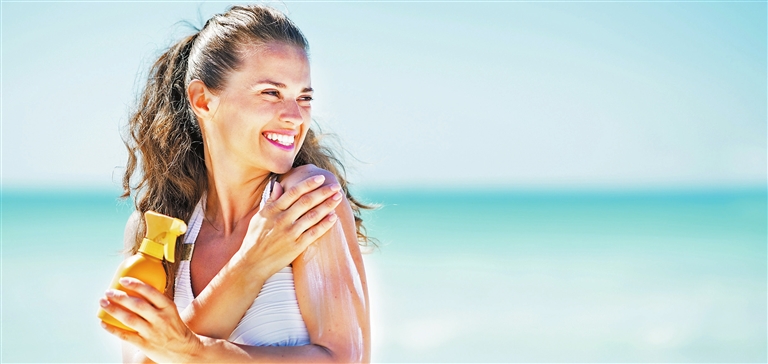
WEARING sunscreen daily is undoubtedly the single best thing you can do for both the health and appearance of your skin. Sunscreens typically fall into one of two categories: chemical or physical. In one corner, you have chemical sunscreens. These contain ingredients — common ones include oxybenzone, avobenzone, homosolate, and octinoxate — that work by penetrating into the skin. There, they absorb UV rays and convert them into a harmless amount of heat, explains Fatima Fahs, a board-certified dermatologist in Michigan, the U.S. On the other hand, physical or mineral sunscreens rely on minerals — titanium dioxide and zinc oxide — that rest on top of the skin, deflecting the sun’s harmful UV rays, explains Orit Markowitz, a board-certified dermatologist in New York City. They each have their pros and cons. “Chemical sunscreens are classically more cosmetically elegant,” says Dr. Fahs. They blend into skin well and typically are undetectable on all skin tones. Because they’re being absorbed into the skin, the final formulas are very lightweight, and it’s also easier to mix chemical sunscreen ingredients into things such as moisturizer and makeup. The drawback? Chemical sunscreens typically contain more ingredients such as preservatives, dyes and fragrances, all of which can potentially cause skin irritation, says Dr. Markowitz. There’s also some concern about chemical ingredients being washed into the oceans and damaging coral reefs; Hawaii, for example, has banned the sale of sunscreens that contain oxybenzone and octinoxate. Physical sunscreens don’t have those potential safety concerns — the U.S. FDA deemed both titanium dioxide and zinc oxide as both safe and effective — nor any negative impacts on the environment. “They’re usually non-comedogenic and tend to be associated with less skin irritation than chemical sunscreens, a good choice for those with acne-prone, oily, or sensitive skin,” adds Dr. Markowitz. But they, too, have drawbacks. Mineral sunscreens can often leave a white or gray cast on the skin, especially in skin of color, says Dr. Fahs. Formulations have improved markedly as of late, and tinted mineral sunscreens can help counteract this, but even then the tints don’t always match all skin tones. Another thing to note: Sometimes, sunscreens will combine both chemical and physical ingredients so that you get the best of both worlds. “They can work in a synergistic way to create a non-irritating and light sunscreen that offers broad-spectrum coverage and is cosmetically elegant,” says Dr. Fahs. Once you’ve figured out whether you want to go the mineral or physical route, you’ll have to choose what format you like (sprays, sticks, creams, etc.). Aerosol sprays may be super easy to use, but Markowtiz warns that their coverage isn’t quite as complete as that of what you’d get from a thicker cream or lotion. Most people simply don’t apply enough, nor rub it in well enough to get the amount of protection indicated on the bottle. Using the right amount is imperative, no matter the type of product you pick. As a general rule of thumb, for lotions and creams you want about a half teaspoon for your entire face, and a shot glass-worth for your whole body. If you are opting for a spray, make sure your entire body is evenly coated; you should be clearly able to see the sheen from the sunscreen. Then, don’t forget to reapply: If you’re spending time outdoors, even if it’s cloudy, reapply your sunscreen every two hours, advises Dr. Fahs. No matter which type of sunscreen you pick, there are a few nonnegotiables to look for. The term “broad-spectrum:” This means the sunscreen is protecting you against both UVA rays, which cause signs of aging, and UVB rays, which cause burning. At least SPF 30: Both the American Academy of Dermatology and the Skin Cancer Foundation recommend at least SPF 30 for daily use. When applied properly, SPF 30 protects you from about 97 percent of UVB rays, says Dr. Fahs, who adds that no sunscreen offers 100 percent protection. Hence why it’s important to practice other safe sun behaviors and seek out shade, wear a hat, etc. And if you’re spending a lot of time outdoors, it’s not a bad idea to up your SPF to a 50 or 70, just to be safe. It should be “water-resistant” if you’re going to the beach: You’ll see this on the bottle with either a 40-minute or 80-minute claim. This indicates how long the sunscreen will stay on wet skin, explains Dr. Fahs. (SD-Agencies) | 
